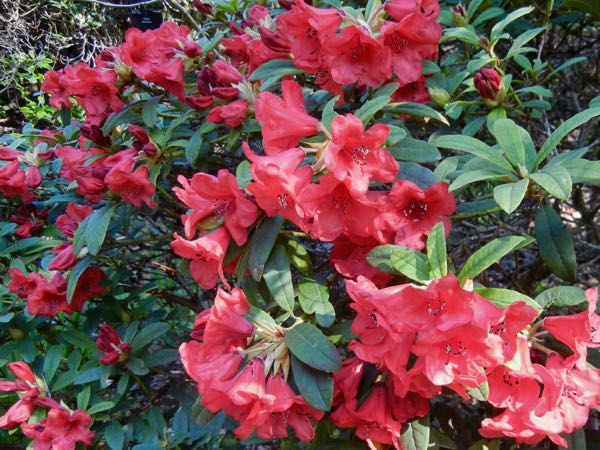Rhododendron ‘Elizabeth’ is a stunning evergreen shrub that belongs to the Ericaceae family of plants. It is a compact and small-leaved hybrid from the Elizabeth Group, reaching a height of approximately 1.2m or 4ft. With its dark green foliage and a profusion of bright red, funnel-shaped flowers, ‘Elizabeth’ adds a splash of color and elegance to any garden or landscape.
How to grow Rhododendron ‘Elizabeth’:
Sunlight and Shade Requirements: When choosing a location for Rhododendron ‘Elizabeth,’ aim for a spot that receives dappled sunlight or partial shade. While it can tolerate some direct sun, too much exposure can lead to scorching of the leaves. A balance of sunlight and shade will ensure optimal growth and flowering.
Soil and Moisture Needs: Rhododendron ‘Elizabeth’ thrives in moist, humus-rich, and well-drained soil. The ideal soil pH for this rhododendron is slightly acidic, ranging from 5.0 to 6.0. If your soil tends to be more alkaline, consider amending it with organic matter, such as compost or well-rotted leaf mold, to lower the pH and create a favorable growing environment.

Propagation Methods:
Propagating Rhododendron ‘Elizabeth’ can be achieved through semi-ripe cuttings or layering. Select healthy, non-flowering shoots and take semi-ripe cuttings in summer. Ensure the cuttings have a heel attached, dip them in rooting hormone, and place them in a well-draining medium. Layering involves bending a low branch to the ground, wounding it slightly, and covering it with soil to encourage root development.
Maintenance and Pruning: Rhododendron ‘Elizabeth’ generally requires minimal maintenance. Regularly monitor the plant’s growth and remove any dead or diseased branches to promote airflow and prevent the spread of diseases. Pruning should be done after the flowering period to avoid removing potential flower buds. Simply trim back any straggly or overgrown branches to maintain a compact and tidy shape.
Common Pests and Diseases: While Rhododendron ‘Elizabeth’ is generally a hardy and disease-resistant plant, it can be susceptible to certain issues. Regularly inspect the plant for signs of powdery mildew, a fungal disease that manifests as a white powdery coating on the leaves. Treat mildew promptly with fungicidal sprays or by removing affected leaves. Additionally, be on the lookout for petal blight, caused by a fungus that affects the flowers, and take appropriate measures to control its spread. Keep an eye out for common pests such as aphids, leafhoppers, caterpillars, and vine weevils. Promptly address any infestations using organic insecticidal sprays or physical removal.
With its vibrant red flowers and dark green foliage, Rhododendron ‘Elizabeth’ is sure to captivate and enhance the beauty of your garden. By providing the appropriate sunlight, well-drained soil, and proactive care, you can enjoy the striking blooms and lush foliage of this magnificent evergreen shrub for years to come.




